How to make a grape pergola with your own hands
The attractiveness and neatness of a summer cottage depends not only on beautiful beds and neat plants. We are talking about country buildings that perform several functions at once. Some serve as a place for relaxation, others are a decorative element and give the garden an original appearance. These functions are combined with a grape pergola - a simple and practical way to grow grapes and make an interesting accessory out of them. What is a pergola, what are its features and how to make it yourself, you will learn from the article.
The content of the article
Pergola for grapes: what is it and why is it needed
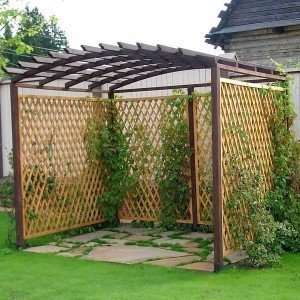
A pergola is a vine arbor, which consists of several arches connected by a lattice roof. It is installed in summer cottages and near garden houses. The design is distinguished by its attractive appearance and originality. Thanks to the pergola, summer residents equip cozy and beautiful places where it is convenient to gather with the whole family. The design creates partial shade and zones the garden area.
The branches of the grapes are tied vertically to create a green wall All leaves and vines are exposed to light, which has a positive effect on the amount of harvest, the bunches ripen at the same time, the berries grow large and juicy. Due to the fact that the grapes are constantly ventilated, the risk of developing fungal and bacterial diseases is reduced. In care, the plant does not differ from those that are grown in the usual way. The arrangement of grapes on the pergola saves space, which is especially true for small areas.
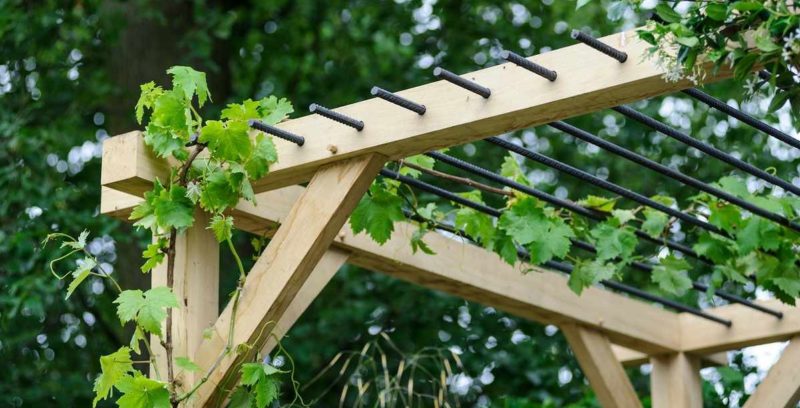
Varieties of pergola
Pergola design and material of manufacture should fit into the general view of the suburban area. Most often it is installed near the house. So she forms a kind of canopywhose wall and roof are made of vines. For example, if the house is wooden, a wooden structure is made in the classic style. If the cottage is built of stone and looks like a medieval house, it is logical to pay attention to the forged structures. With a limited budget, simple pergolas from a profile pipe are chosen.
Wooden
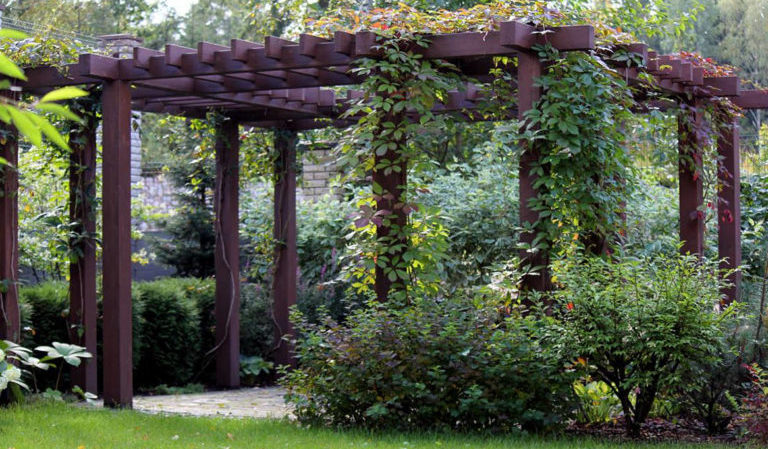
The tree is appreciated for its aesthetic and laconic appearance, accessibility and ease of processing, environmental friendliness... For manufacturing, oak or larch is used. The material is expensive, but it is reliable and has a long service life. More budgetary species - pine or birch - are suitable for making the simplest structures.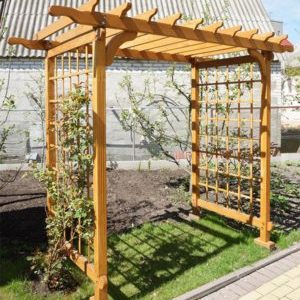
They are distinguished in shape by round, square, semicircular. The choice depends on the size of the garden and personal preference. Lattice structures are often found, they look interesting and fit into any setting. Vines entwine the tree, giving it lightness and airiness. Benches and a wooden table will complement this pergola. It's nice to get together with friends on the open veranda.
In order for the wooden pergola to serve for a long time, the blanks are thoroughly dried in the sun before being made and treated with an antiseptic and moisture-repellent agent. The tree does not tolerate moisture well, due to rains and watering the grapes quickly deteriorate and lose their presentation. To prevent this from happening, every year the structure is lubricated with resin or paraffin to create a protective layer.
Read also:
Kesha grape hybrid - description and characteristics
Metal
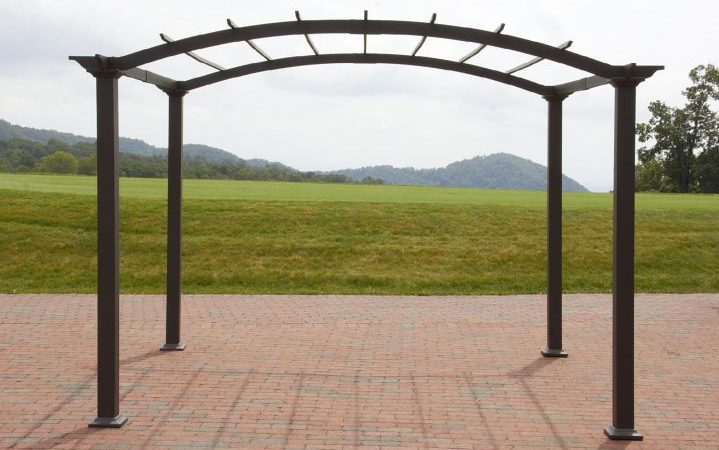
Compared to wood, metal is more durable and easier to maintain, but it is more expensive... Making such a pergola requires the skills of a welder and a welding machine. A profile pipe is used as a basis. Products are easily bent, with their help, designs give a stylish appearance.
Arches for pergolas are created from square or rectangular pipes; it can be one massive structure or several small ones that create the effect of a tunnel. After production, the profile pipes are painted to protect against corrosion. The lighter it is, the more weightless the structure seems.
Forged products are also popular, for example, in the form of an awning or a screen. The forging pattern can be strict, consisting of straight lines, or ornate, with patterns and wavy elements that intertwine with each other.
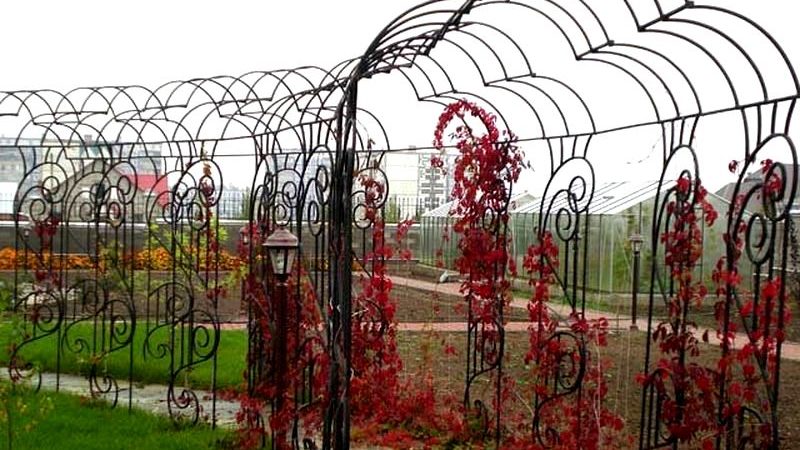
Interesting! A forged pergola in the form of a bench will become a favorite place on the site. The arched metal structure consists of a bench with a canopy. The pergola itself is decorated with wrought iron patterns that are intertwined with green grape vines. If there are children in the house, a swing is installed instead of a stationary bench.
Made of plastic
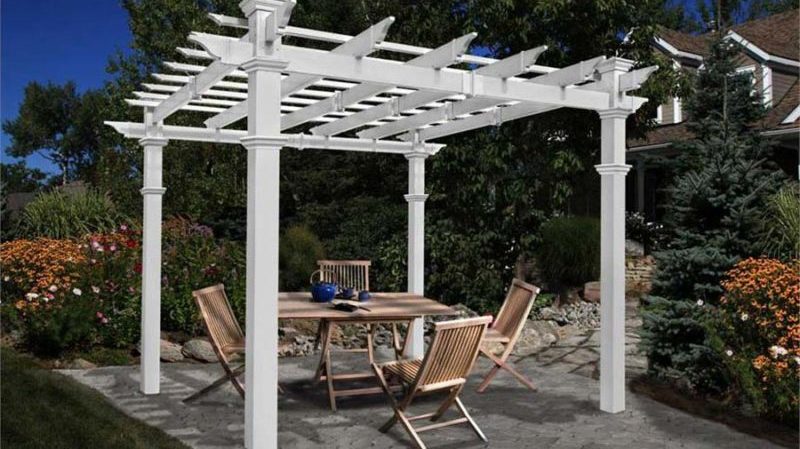
Plastic is appreciated for its frost resistance and a large selection of different options. It does not fade in the sun, washes quickly, is protected from the formation of fungus and mold. Plastic garden elements are great for those who are just deciding to install a pergola for grapes on their site and do not yet have experience in growing this crop in this way.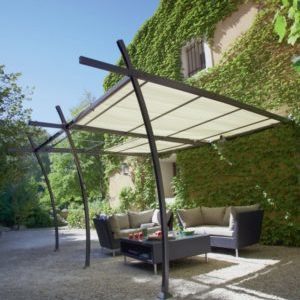
Plastic is very light and affordable, you can find such a design in any gardening store. It is easy to assemble, reminiscent of a large construction set. Outwardly, such pergolas do not fit into all areas, but when the grapes grow, the green shoots will hide the plastic.
The best option for a garden is a polycarbonate pergola. The material is durable and resistant to external influences, fits into any landscape design. Manufacturers offer pergolas of any color, even transparent ones. Install the structure thoroughly, in cement. But it is better to refuse PVC - the material is very cheap, but it is not environmentally friendly and, when heated in the sun, spreads an unpleasant smell.
Read also:
Stone
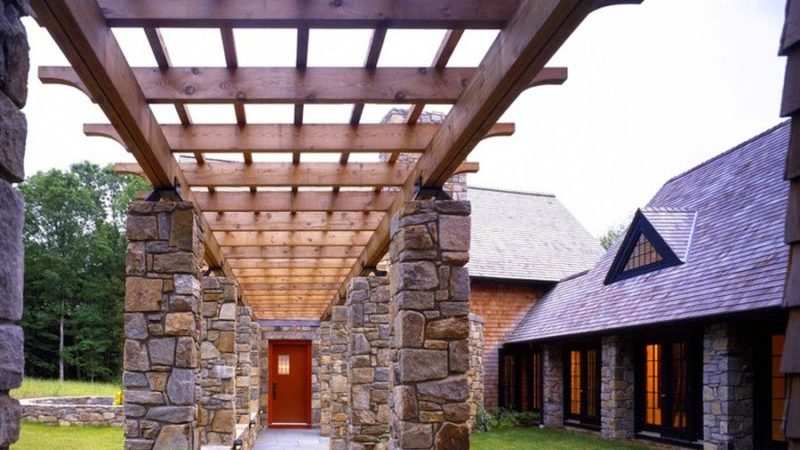
It is difficult to call a stone pergola just a support for grapes; it is rather an element of art in a summer cottage. This design has served for decades without losing its attractiveness. For production, artificial or natural stone (basalt, granite, marble) is used. The cost of such a structure is comparable to the price of a small summer house, so this option definitely cannot be called cheap. At the same time, other materials cannot be compared with stone in terms of service life and reliability. He is not afraid of temperature changes, moisture, shocks and other external influences.
Interesting! To create an antique style in the garden, pergolas with columns and statues made of light marble are used, for the oriental style - in the form of Chinese or Japanese palaces. Designs are decorated not only with grapes, but also with ivy, roses, lianas. For the manufacture of such elements, they turn to specialized companies.
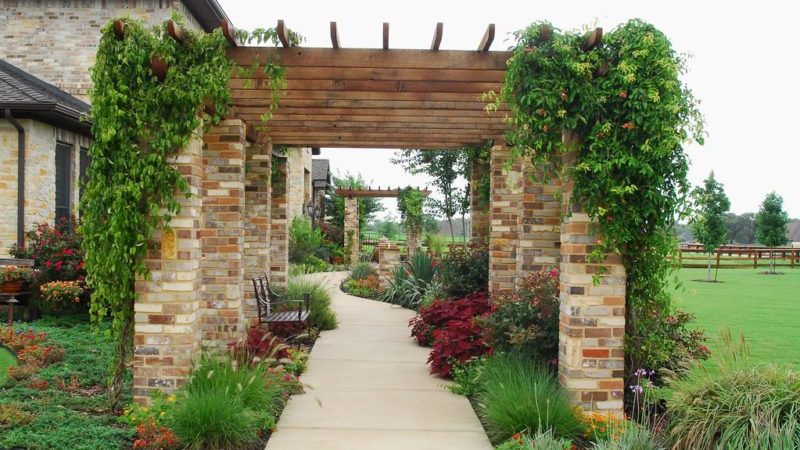
How to make a pergola with your own hands
To create a pergola with their own hands, summer residents prepare the necessary tools and drawings in advance, determine the design of the building, choose a suitable place. Consider how to make a grape pergola from a tree with your own hands.
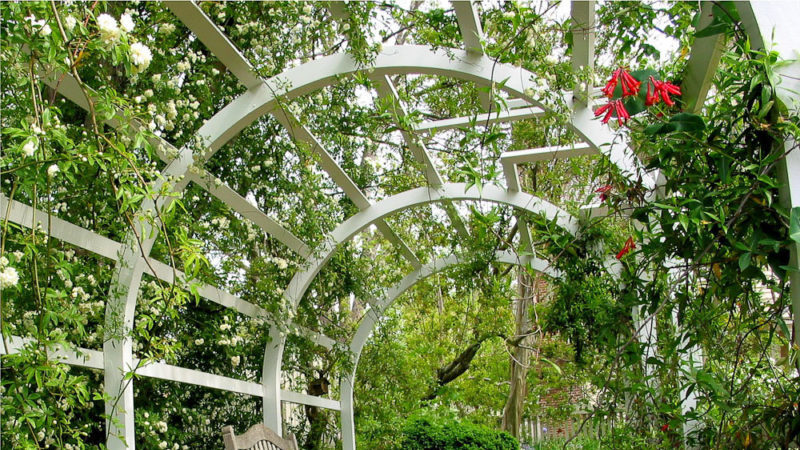
Required materials and tools
For the manufacture of pergolas, fruit tree species are not used; it is better to purchase acacia, larch, pine, spruce. Beams or logs are used as support pillars, pine boards are used for the roof. The harder the rock, the longer the service life of the building.
Craftsmen prepare an ax, a hammer, a saw, a screwdriver, a tape measure, screws and twine.You will also need cement, sand, nails and screws, crushed stone and a container for mixing the solution. The wood is treated with an antiseptic, and to give the original color it is varnished and painted.
Site selection and preparation
Grapes love light and warmth, so the place for the pergola is sunny and well lit. If you put it in the shade or partial shade, the vines develop slowly, the leaves do not acquire a rich green hue. It is important to remember that a pergola is a capital structure; it will not work to move it to another place.
Most often, the pergola is placed near:
- garden house or veranda;
- pool or pond;
- trees or garden fence.
Pergola construction process
The initial stage is drawing up a drawing. It indicates the proportions of the future product, its features, the amount of material required. It is recommended to draw up a diagram of the site and imagine how the pergola will fit into its environment. After that, the construction process begins:
- Level the site and make marks for the future structure.
- Dig a trench 30 cm deep for the base of the pergola wall.
- Mix the solution.
- Broken bricks and crushed stone are poured into the trench, tamped down.
- They lay out a wall 40 cm high, build a support from vertically arranged bars.
- At a distance of 1 m from the wall, holes for the bars are dug at intervals of 2 m.
- Install the bars and fill them with cement mortar.
- Bars in the shape of the letter T are laid on the supports.
- On the sides of the pergola, veneer lathing is made.
Conclusion
To decorate a garden or cottage, wooden, metal, forged, plastic and stone pergolas are used. Structures are rectangular or rounded, multi-tiered or arched. Wood and metal are environmentally friendly, they are used more often than other materials. Plastic is inexpensive and easy to install, and stone will transform your garden into a work of art.
In order for the pergola to serve for a long time, it is recommended to choose a suitable location and follow the recommendations of experienced craftsmen during manufacturing.